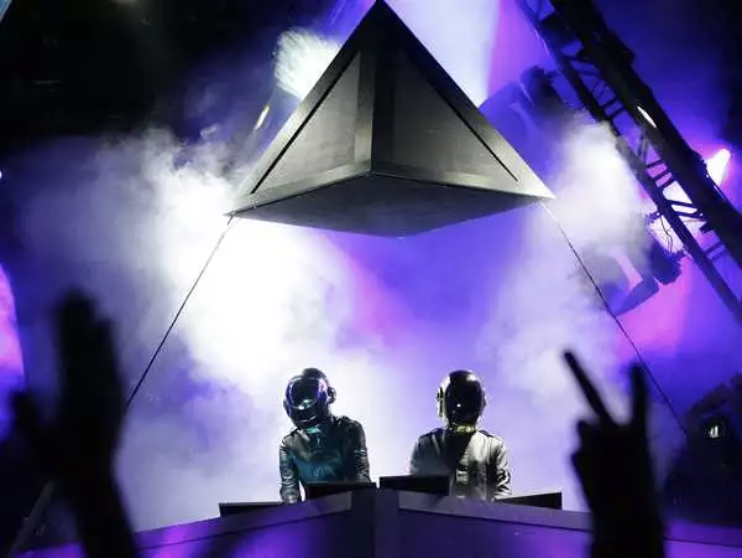Before EDM, There Was Daft Punk
By Raeya Ponugoti, Staff Writer
Dubbed by Billboard as “the most influential electronic act of its time,” Daft Punk was a French duo consisting of musicians Guy-Manuel de Homem-Christo and Thomas Bangalter. Rising from the French house music scene, Daft Punk achieved popularity after their formation in 1993. Daft Punk not only dramatically inspired the sound of the current most popular genre of electronic music--EDM (electronic dance music)--but they also invented the accompanying live light show. Although we’re decades after their prime, Daft Punk’s impact on the music world only gets clearer.
Combining elements of genres like funk, pop, indie rock, and techno, Daft Punk created a series of timeless works, including “Harder, Better, Faster, Stronger”--one of their most famous songs. A live performance of this track released after its appearance in their second studio album, Discovery, won the Grammy for Best Dance Recording in 2009. The music video was produced by Japanese animation house Toei Animation, the creators of popular anime like Sailor Moon and Dragon Ball. The work was also sampled by rapper Kanye West for his song “Stronger,” which proceeded to top the Billboard charts and win a Grammy for Best Solo Rap Performance. An article written in 2016 for the Huffpost reads, “Fifteen years on from its release and it’s hard to think of a dance track that’s as prominent in popular culture or influential to modern electronic music.”
This track makes Daft Punk’s ingenuity abundantly clear. Through modulation and other effects, the duo blurs the lines between voice and instrument. To Daft Punk, voice as an electronic instrument is just as important as a synthesizer or keyboard. The layers in their compositions are so complex, it’s almost guaranteed you will hear something new with every listen.
In 2005, Daft Punk released Human After All, their only studio album that didn’t receive wide critical acclaim and mainstream adoration. “Robot Rock,” a track off Human After All, initially amassed mostly negative criticism, with one critic even saying it “does nothing, means nothing and goes nowhere for an unconscionably long time” (Weiner). Nevertheless, the success of this track proved songs did not have to adhere to any particular structure in order to be loved. Besides a few iconic tracks like the former, Human After All was largely a flop. The collective consensus was that Daft Punk had reached their peak, that they had nothing new to offer —until the moment their live set began on April 29th, 2006.
From a pitch black stage, the crowd first heard the theme to Stephen Spielberg’s Close Encounters of a Third Kind, a film about Earth receiving a visit from extraterrestrials. This set the scene for the experience to come. A momentary spotlight flashed, reflecting off their metal helmets and revealing the duo as the word “Robot” coursed through the speakers. What followed was arguably the most iconic live set in music history.
Atop a glowing grid pyramid, Daft Punk produced a symphony of sonic and visual experience that left the audience feeling like “something cataclysmic had unfurled before their eyes, and music would never be the same again.” And it wasn’t. “The fact that this set coincided perfectly with the rapid uptake in EDM music the world over is proof of its seismic influence.” This set invented and effectively ensured that laser beams and light shows would forever be intertwined with its live performance.
Although Daft Punk’s light shows are characteristic of electronic music concerts today, upon listening, the entire vibe of Daft Punk’s work seems drastically different from the electronic music we hear today, structurally and otherwise. Even so, their influence on EDM artists is undeniable. In a 2013 interview with NME, Thomas Bangalter revealed that Skrillex, one of EDM’s biggest names, “said that he saw [their] live show with the pyramid in 2007 and it made him want to make music.” Other prominent EDM artists like Zedd, Porter Robinson, and Dillon Francis have all expressed similar, career-igniting moments of inspiration from first hearing the duo’s music.
Even though Daft Punk tragically disbanded this past year, their impact on music as a medium will never pale. Leaving us with iconic works like “Harder, Better, Faster, Stronger,” and a plethora of other gifts, we will forever be indebted to these two musicians. Not only will we continue to see their work referenced in popular culture, we get to dance to the products of their metaphoric descendants for as long as humans continue to produce electronic music.

